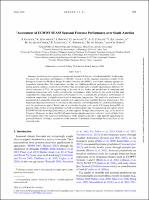| dc.contributor.author | Gubler, S. | |
| dc.contributor.author | Sedlmeier, K. | |
| dc.contributor.author | Bhend, J. | |
| dc.contributor.author | Avalos, Grinia | |
| dc.contributor.author | Coelho, C.A.S. | |
| dc.contributor.author | Escajadillo Fernandez, Yury | |
| dc.contributor.author | Jacques-Coper, M. | |
| dc.contributor.author | Martinez, R. | |
| dc.contributor.author | Schwierz, C. | |
| dc.contributor.author | De Skansi, M. | |
| dc.contributor.author | Spirig, C. | |
| dc.date.accessioned | 2020-07-28T01:51:56Z | |
| dc.date.available | 2020-07-28T01:51:56Z | |
| dc.date.issued | 2020-03-11 | |
| dc.identifier.uri | https://hdl.handle.net/20.500.12542/424 | |
| dc.description.abstract | Seasonal predictions have a great socioeconomic potential if they are reliable and skillful. In this study, we assess the prediction performance of SEAS5, version 5 of the seasonal prediction system of the European Centre for Medium-Range Weather Forecasts (ECMWF), over South America against homogenized station data. For temperature, we find the highest prediction performances in the tropics during austral summer, where the probability that the predictions correctly discriminate different observed outcomes is 70%. In regions lying to the east of the Andes, the predictions of maximum and minimum temperature still exhibit considerable performance, while farther to the south in Chile and Argentina the temperature prediction performance is low. Generally, the prediction performance of minimum temperature is slightly lower than for maximum temperature. The prediction performance of precipitation is generally lower and spatially and temporally more variable than for temperature. The highest prediction performance is observed at the coast and over the highlands of Colombia and Ecuador, over the northeastern part of Brazil, and over an isolated region to the north of Uruguay during DJF. In general, Niño-3.4 has a strong influence on both air temperature and precipitation in the regions where ECMWF SEAS5 shows high performance, in some regions through teleconnections (e.g., to the north of Uruguay). However, we show that SEAS5 outperforms a simple empirical prediction based on Niño-3.4 in most regions where the prediction performance of the dynamical model is high, thereby supporting the potential benefit of using a dynamical model instead of statistical relationships for predictions at the seasonal scale | en_US |
| dc.format | application/pdf | |
| dc.language.iso | eng | en_US |
| dc.publisher | American Meteorological Society | en_US |
| dc.relation.ispartof | urn:issn:1520-0434 | |
| dc.rights | info:eu-repo/semantics/openAccess | |
| dc.rights | Atribución-NoComercial-SinDerivadas 3.0 Estados Unidos de América | * |
| dc.rights.uri | http://creativecommons.org/licenses/by-nc-nd/3.0/us/ | * |
| dc.source | Repositorio Institucional - SENAMHI | |
| dc.source | Servicio Nacional de Meteorología e Hidrología del Perú | |
| dc.subject | Climatología | |
| dc.subject | South America | en_US |
| dc.subject | Precipitación | |
| dc.subject | Pronóstico | |
| dc.title | Assessment of ECMWF SEAS5 seasonal forecast performance over South America | en_US |
| dc.type | info:eu-repo/semantics/article | en_US |
| dc.identifier.isni | 0000 0001 0746 0446 | en_US |
| dc.description.peerreview | Por pares | |
| dc.identifier.doi | https://doi.org/10.1175/WAF-D-19-0106.1 | |
| dc.identifier.journal | Weather and Forecasting | en_US |
| dc.subject.sinia | precipitacion - Clima y Eventos Naturales | |
| dc.type.sinia | text/publicacion cientifica | |
| dc.identifier.url | https://hdl.handle.net/20.500.12542/424 | |









